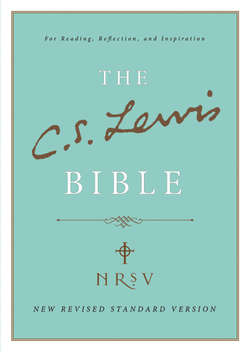Читать книгу C. S. Lewis Bible: New Revised Standard Version - Клайв Льюис, Клайв Стейплз Льюис - Страница 11
How to Read The C. S. Lewis Bible
ОглавлениеImagine if C. S. Lewis were your Oxford tutor or Bible teacher. What would he say, and how would he teach and inspire you? He’d ask the tough questions. He’d make you wrestle with Scripture. He wouldn’t let you get off easy. The C. S. Lewis Bible was developed in order to put his wisdom and insight side-by-side with the Scriptures so that readers might benefit from the years Lewis gave to close personal study of the Bible as it informed his own writing.
In over six hundred readings paired alongside relevant passages in the Bible, C. S. Lewis is offered as a companion and guide to a reader’s daily study of Scripture. As you come across one of these readings within the Bible text, imagine Lewis sitting alongside you, making observations on Scripture. As Lewis did in his daily study, wrestle with the Scriptures, allow his questions to make you dig deeper in the text to look for answers, and set aside time to pause and reflect.
One can deduce from Lewis’s own practices that there are many ways to read The C. S. Lewis Bible—or any other Bible, for that matter. It can, and perhaps ought to be, read cover to cover—as you might read any other book. In fact, the Bible can be read, at a speaking speed, in approximately eighty hours. This means it takes no more than thirteen minutes per day to read through the Bible from start to finish in a year; this is less time than is given over to commercials in one hour of television. Another way is to study one book of the Bible per month, reading that book over and over, each day, in that given month, taking notes on it and exploring its context in greater depth. Furthermore, the Bible could be read thematically. To do this, while reading it through from start to finish, follow a particular theme throughout. Mark down references as you note the frequency of the theme each time it is mentioned. Follow themes like the love of God, the promises of eternal life, our obligation to the poor, the sanctity of life, our responsibility for the environment, and other topics to keep you engaged with the text and to discover what God’s word says on that theme. Each read through the Bible will give you a topical reference tool for studying, in depth, God’s wisdom concerning that particular idea.
The Bible is the most important book ever written. If The C. S. Lewis Bible will encourage you to read it faithfully, then the work of the editors has been worthwhile. It has not been their design to give you more of Lewis any more than a person who puts a frame on a Rembrandt wants to give you more of a frame. The goal of the editors is that the readers of this Bible will become more enamored with the God of the Bible. Lewis is merely a tool to accomplish that end. The editors are convinced that Lewis himself would have had it no other way.
2. C. S. Lewis, “The Literary Impact of the Authorised Version” (1950), in Selected Literary Essays, ed. Walter Hooper (Cambridge: Cambridge Univ. Press, 1969), p. 144.
3. C. S. Lewis, “Cross-Examination” (1963), in God in the Dock: Essays on Theology and Ethics, ed. Walter Hooper (Grand Rapids, MI: Eerdmans, 1970), p. 266.
4. C. S. Lewis, The Four Loves (New York: Harcourt, 1960), p. 14.
5. C. S. Lewis, “Is Theology Poetry?” (1944), in The Weight of Glory: And Other Addresses, ed. Walter Hooper (New York: Touchstone, 1996), p. 106.
6. C. S. Lewis, The Allegory of Love: A Study in Medieval Tradition (Oxford: Oxford Univ. Press, 1936), p. 130.
7. C. S. Lewis, Prince Caspian: The Return to Narnia (New York: Macmillan Publishing Co., 1951), p. 182.
8. C. S. Lewis, A Grief Observed (London: Faber and Faber, 1966), pp. 25, 56, 60.
9. C. S. Lewis, A Grief Observed (London: Faber and Faber, 1966), p. 55.
